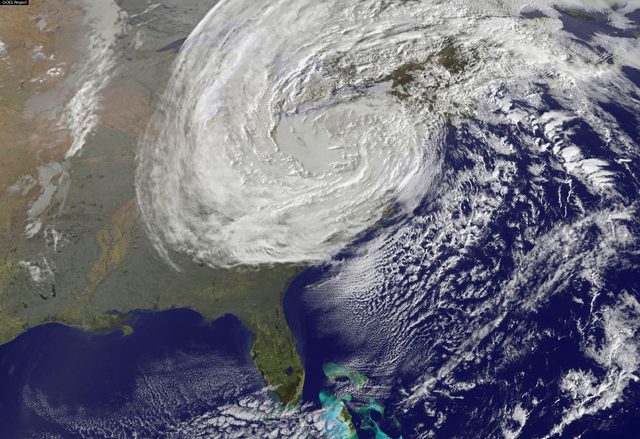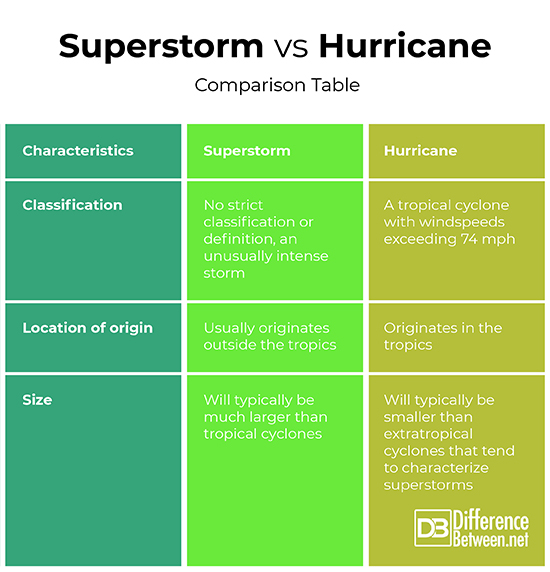Difference Between Superstorm and Hurricane
What is Superstorm?
A superstorm is a storm system that does not have a specific meteorological definition. It is used to refer to storms that are unusually intense and do not fit into any particular category. The term has been applied to storm systems happening in a variety of climates ranging from near the tropics to cold temperate latitudes.
History of the use of the term
Meteorologists began using the term superstorm in the 1990s to describe especially powerful storms. One example is the Braer storm that occurred on January 10, 1993. The storm originated as a low-pressure system over the north Atlantic between northwest Scotland and Iceland. It also led to the final destruction of the Braer, an oil tanker that had been shipwrecked a week before in the Shetland Islands. A more recent example of a storm that was called a superstorm was superstorm Sandy which devastated the Caribbean in 2012. It started out as a tropical cyclone or hurricane but morphed into a superstorm over the course of its development. Before the 1990s, terms like “perfect storm” and “storm of the century” were used to refer to these types of weather disturbances.
One early example of this type of storm that was recorded in historical times was the Great Gale of 1880. This storm caused blizzards and record snowfall in the American Pacific Northwest, particularly Oregon.
Common Characteristics
Although there is no clear meteorological definition for a superstorm, there are some common characteristics. Superstorms are typically extratropical cyclones and they do not occur frequently, usually only once every few decades.
What is Hurricane?
A hurricane is another name for a type of tropical cyclone. It is an intense storm that originates in the tropics and can migrate into subtropical and temperate climatic zones. It is characterized by powerful winds that go in a circular route around a clearly defined central “eye” of low pressure which is surrounded by higher pressure regions.
Terminology of Hurricane
Hurricanes are known by different names depending on where they occur in the world. In the northwestern Pacific, they are called typhoons. In the southwestern Pacific and the Indian Ocean, they are simply called tropical cyclones. Hurricanes are specifically tropical cyclones that occur in the Atlantic Ocean.
Structure of Hurricane
A hurricane has a specific structure because of its meteorological characteristics. Wind in the main body of the hurricane, surrounding the eye, travels rapidly in a circular motion while also moving radially inward towards the center of the hurricane. When the wind reaches the edge of the eye of the hurricane, the wind and precipitation are at their most intense.
Central Eye
The eye of the hurricane is the central part of the storm. In the main cloud disk of the hurricane, powerful winds rage. The eye of the hurricane is a region of extremely low pressure where the air is relatively still, and the sky is often clear, especially in the most powerful storms. This creates an eerie region of calm weather in an otherwise ferocious storm.
Eyewall
The wind in the eyewall is the fiercest of anywhere else in the Hurricane. The most damage done by a hurricane typically occurs when the eyewall passes over. Periodically, the eyewall will be reorganized or replaced which will cause changes in the storm’s intensity. In especially large hurricanes, a secondary eyewall can form in addition to the primary eyewall.
Scale and Classification
Hurricanes are classified as tropical cyclones, however not all tropical cyclones are hurricanes. Only tropical cyclones with a maximum windspeed that exceeds 74 mph (118.4 km/h) are classified as hurricanes. Tropical cyclones with a maximum windspeed that is less than 74 mph but greater than 39 mph (62.4 km/h) are classified as tropical storms. Tropical cyclones with windspeeds less than 39 mph are called tropical depressions. Typically, the largest and most intense tropical cyclones occur in warmer waters.
Formation of Hurricanes
Heat released from warm oceans near the equator into the atmosphere can create lower pressure areas that can lead to the formation of cyclones. If enough energy is added to these tropical cyclones, they can become true hurricane-level storms.
Similarities between superstorms and hurricanes
Hurricanes and superstorms both lead to powerful weather disturbances involving high windspeeds and heavy precipitation. Superstorms are also similar to hurricanes in that they tend to be cyclonic.
Differences between superstorms and hurricanes
Although there are similarities, there are also significant differences between superstorms and hurricanes. These differences include the following.
- Hurricanes represent a specific type of storm with certain requirements and parameters while what counts as a superstorm is more nebulous.
- Hurricanes are tropical cyclones whereas superstorms tend to be extratropical cyclones.
- The extratropical cyclones making up superstorms tend to be much larger than the tropical cyclones that are called hurricanes.
Superstorm vs. Hurricane: Comparison Table
Summary of Hurricane Vs. Superstorm
- Superstorms are especially powerful storms that do not have an exact meteorological definition. Superstorms usually originate as extra-tropical cyclones and usually only happen once every few decades because of their scale.
- Superstorms can result in winter storms, such as blizzards, and storms that occur in warmer climates closer to the equator.
- Hurricanes are tropical cyclones that originate near the equator where the water is warm and releasing excess heat into the atmosphere.
- Tropical cyclones can migrate to subtropical or temperate latitudes before dissipating. Hurricanes have windspeeds greater than 74 mph. Depending on where they occur in the world, they can be called hurricanes, typhoons, or simply tropical cyclones.
- The wind in a hurricane travels in a circular path around a low-pressure area creating a distinctive disk of clouds with a clearly defined central “eye.”
- Superstorms and hurricanes differ in that hurricanes have a specific definition and form only in the tropics whereas superstorms do not have an agreed upon definition but are usually extratropical in origin.
- Difference Between Environmental Performance Index and Development - November 24, 2023
- Difference Between Environmental Intervention and Development - November 8, 2023
- Difference Between Eco Efficiency and Eco Effectiveness - September 18, 2023
Search DifferenceBetween.net :
Leave a Response
References :
[0]Image credit: https://en.wikipedia.org/wiki/Hurricane_Irma#/media/File:Irma_2017-09-05_1706Z.jpg
[1]Image credit: https://upload.wikimedia.org/wikipedia/commons/thumb/b/ba/Superstorm_Sandy_on_10-30-2012.png/640px-Superstorm_Sandy_on_10-30-2012.png
[2]Trenberth, Kevin E. "Warmer oceans, stronger hurricanes." Scientific American 297.1 (2007):44-51.
[3]McCallum, E., and N. S. Grahame. "The Braer storm—10 January 1993." Weather 48.4 (1993): 103-107.
[4]“January 9, 1880 ‘Storm King’” by Wolf Read. Available at: http://www.climate.washington.edu/stormking/January1880.html Kossin, James P., and Matthew Sitkowski. "An objective model for identifying secondary eyewall formation in hurricanes." Monthly Weather Review 137.3 (2009): 876-892.
[5]Hoffman, Ross N. "Controlling hurricanes." Scientific American291.4 (2004): 68-75.



